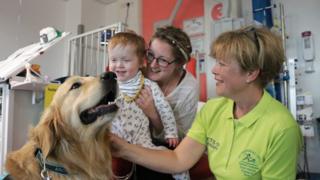 Image copyright
Image copyright
UHS
Southampton Children’s Hospital is studying animal therapy on wards
Hospitals should let more dogs and other animals on to wards and even into operating theatres to help patients, the Royal College of Nursing says.
The call comes after the RCN collected scores of anecdotes of therapy-animals, and sometimes pets, helping recovery.
Some young patients found having trained dogs accompany them to the anaesthetic room reduced their anxiety before and after surgery.
The RCN is working on national advice to encourage more animal visitors.
‘Myths and dangers’
In a recent RCN survey of 750 nursing staff, 82% said animals could help patients be more physically active and 60% said they believed animals improved physical recovery.
But many nurses said animals were not allowed where they worked.
The main reasons behind this, according to Amanda Cheesley, who is putting together nationwide guidelines on animals in hospitals, are concerns that furry companions spread infections and other “myths around the dangers” of allowing animals on wards.
But she says she knows of examples where hospitals allowed dogs and other animals on wards safely, making a “remarkable difference.”
She mentioned one young cancer patient who was too scared to have a life-saving procedure in theatre.
The patient finally had the treatment she needed after a therapy dog accompanied her to the anaesthetic room and stayed with her afterwards.
Ms Cheesley said: “The dog calmed her down, making it so much less traumatic for her and her parents. Ultimately it allowed the staff to do a life-saving job.”
Another example involved a man who had had a brain injury that left him with difficulty walking.
After he was discharged, he found going for a walk with his pet donkey helped with his balance and, over time, he was able to walk more easily.
Ms Cheesley says more trained animals could help with mobility and physiotherapy – for example, by asking patients to walk towards a dog at the end of a walkway and gradually increasing the distance.
Dogs could also help divert a patient’s attention – for example, if a child is scared of needles, a therapy dog could act as a distraction.
‘Pet protocol’
To collect more evidence on the benefits and challenges of bringing animals on to wards, dog handler Lyndsey Uglow who has worked with therapy-animals in hospitals for five years, has started a research project at Southampton Children’s Hospital.
Image copyright
UHS NHS Trust
Golden retriever Leo visits children in Southampton General Hospital
Together with Ms Uglow, the Humanimal Trust, infection control specialists and hospital managers, the RCN aims to put together simple rules that could work across wards, clinics and hospices.
Concerns that pets might pass on infections for example, could be addressed by making sure animals do not wander from room to room or patient to patient, but are instead booked for a specific patient at a specific time.
Owners would also have to ensure the animal’s vaccinations were up-to-date.
And handlers could clean paws with hospital-grade wipes.
Don’t be scared to let animals on wards, say nurses

